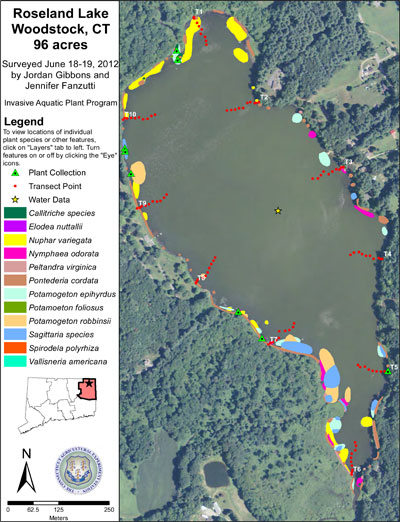AQUATIC PLANTS AT ROSELAND LAKE
ALSO SEE: Vegetation | Invasives | Wildlife
A late season survey indicated that submergent waterweed and smartweed is sparse to occasional in waters less than 3 feet deep. Much of the lake is fringed with emergent pickerelweed and Bur-reed (Scirpus sp.) and floating mats of White Waterlily and Yellow Pond-lily. (A Fisheries Guide to Lakes and Ponds of Connecticut, 2002)
Aquatic invasives have been found in about 60% of CT lakes surveyed, so Roseland Lake is at risk. Aquatic invasives found in nearby lakes include Variable-leaf Milfoil, Brazilian Waterweed and Minor Niad. Boaters or anglers could inadvertently bring these plants to Roseland Lake, resulting in an infestation that would be almost impossible to control.
YOU can help keep Roseland Lake free of aquatic invasive plants and animals. Never put aquarium plants, live crayfish, fish or other animals into lakes or streams. Before launching, boaters and paddlers need to: CLEAN, DRAIN AND DRY. Inspect equipment and remove any hitchhiking aquatic plants or animals, drain all water, and dry or disinfect. Anglers should dispose of unwanted bait in the trash.
2012 AQUATIC PLANT SURVEY
In 2012, the Connecticut Agricultural Experiment Station conducted an aquatic plant survey at Roseland Lake in Woodstock, to look for invasive plants. The results are found here:http://www.ct.gov/caes/cwp/view.asp?a=2799&q=514228. A map of what plants were found where is also online, or available for download as a PDF file on this website.
They identified 12 plant species, none of which were invasive. (Invasive Phragmites (Common reed) does grow on the shoreline in spots.) The plants they found were:
- Callitriche species (Water-starwort)
- Elodea nuttallii (St. John Western Waterweed)
- Nuphar variegata (Variegated Yellow Pond-lily). This was the most dominant species. It grew in large patches to teh north, as well as smaller patches along the western and southern shore.
- Nymphaea odorata (American White Waterlily). Found in the southern cove.
- Peltandra virginica (Green Arrow Arrum). Found in the southern cove.
- Pontederia cordata (Pickerelweed). This shorelines species was found growing along much of the shoreline.
- Potamogeton epihydrus (Ribbonleaf Pondweed). Found in the southern cove.
- Potamogeton foliosus (Leafy pondweed). Found in the southern cove.
- Potamogeton robbinsii (Robbins' Pondweed). Found in the southern cove.
- Sagittaria sp. (Arrowhead). Found in the southern cove.
- Spirodela polyrhiza (Common Duckmeat)
- Vallisneria americana (American Eelgrass). Only one plant was seen along the eastern shoreline.
This was good news, because invasive milfoil has been seen upstream of Roseland Lake.
The survey team noted that "The most species rich area was in the southern cove. This area was very shallow, allowing for light to reach the bottom, and enabling greater plant growth."
Jean Pillo of the Woodstock Conservation Commission noted: "The dissolved oxygen in the lake drops to lethal levels at 3 meters and the total phosphorus concentrations in the bottom of the lake were 334.9 ppb – a very high number! In freshwater systems, phosphorus is typically the limiting factor for plant growth. The measure of water transparency, or Secchi disk measurement was 1.5 meters. Low dissolved oxygen on the bottom and low light levels would both contribute to the relative lack of submerged aquatic vegetation in the lake. The date of the survey was June 19, 2012. Last year, we had an early spring so plant and algae growth got a head start." Read more about water quality at Roseland Lake.
Note: Lake survey data is also available for Crystal Pond and Black Pond in Woodstock, CT
MORE INFO:
- Invasive species in CT - CT DEEP
